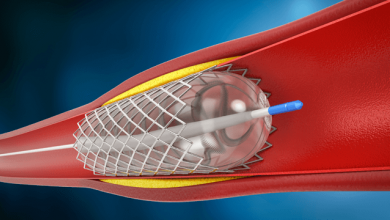Search results
Author(s):
Rick Volleberg
,
Stijn van den Oord
,
Robert-Jan van Geuns
Added:
1 year ago
Author(s):
Walter Desmet
Added:
3 years ago
Since its introduction in 1977, the long-term benefits of percutaneous coronary intervention have been limited by the phenomenon of restenosis, i.e. the recurrence of significant stenosis at the site of intervention. While in restenosis after plain balloon angioplasty roughly two-thirds of the late lumen loss is due to negative vessel wall remodelling, the late lumen loss after stent implantation…
View more
Author(s):
Adrian P Banning
,
Kristin L Hood
,
Aloke V Finn
,
et al
Added:
3 years ago
Patients with diabetes have abnormalities in the growth and function of arterial smooth-muscle and endothelial cells and consequently have a particularly aggressive and diffuse pattern of atherosclerosis, leading to increased cardiovascular complications and mortality compared with the non-diabetic population.1–4 However, the molecular signalling underlying the accelerated atherosclerosis in…
View more
Advances in New Stent Designs without a Permanent Polymer May Solve Polymer-related Complications
Author(s):
Chourmouzios A Arampatzi
,
Raul Moreno
,
Giuseppe Sangiorgi
Added:
3 years ago
Article
Author(s):
James Gilbart
Added:
3 years ago
In coronary artery stents, the coverage of the internal structures with neo-intimal formation has been regarded as a negative development leading to restenosis and loss of luminal space in the blood vessel. However, some coverage of the stent can be beneficial, providing coverage of protrusions in the internal stent structure that may otherwise constitute a thrombotic risk. Recent studies have…
View more
Author(s):
Fumiyuki Otsuka
,
Masataka Nakano
,
Saami K Yazdani
,
et al
Added:
3 years ago
Percutaneous coronary interventions (PCI) involving stenting are the most widely performed procedures for the treatment of symptomatic coronary disease.1 Although first-generation sirolimus-eluting stents (SES; Cypher™, Cordis Corp., Miami Lakes, FL) and paclitaxel-eluting stents (PES; Taxus™, Boston Scientific, Natick, MA) have radically reduced restenosis,2,3 complications of late (LST) and…
View more
Author(s):
Bruno Scheller
,
Bodo Cremers
,
Stephanie Schmitmeier
,
et al
Added:
3 years ago
One of the most innovative fields of modern medical research is the percutaneous transluminal treatment of vascular disease. Coronary angioplasty was clinically introduced by Andreas Grüntzig in 1977.1 In the coronary field the most important improvement in angioplasty has been achieved with the introduction of stents. A significant proportion of complex modern coronary interventional techniques…
View more
Bioresorbable Scaffolds
Author(s):
Sidakpal Panaich
,
Theodore Schreiber
,
Cindy Grines
Added:
3 years ago
Article
Author(s):
Kalpa De Silva
Added:
1 year ago
Author(s):
Katrina Mountfort
Added:
3 years ago
Proceedings of Two Satellite Symposia Held at EuroPCR in May 2015 in Paris
The use of second-generation polymeric metallic drug-eluting stents (DES) in percutaneous coronary intervention (PCI) is now routine practice and has demonstrated excellent safety and efficacy compared with first-generation DES. These stents have enhanced PCI procedures, enabling the treatment of more complex lesions and…
View more












